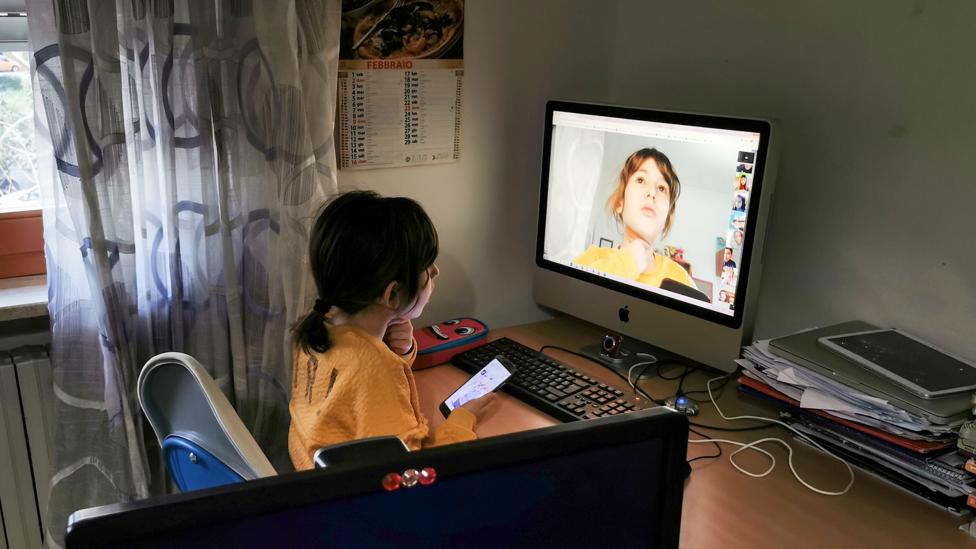Then the coronavirus pandemic struck. Our houses crowded with confused family members displaced from their schools, workplaces, daycares, and routines. Screen time rules scattered to the winds like so many viral particles, and everywhere children feasted upon YouTube and Netflix, Minecraft and Messenger Kids.
None of the experts are upset that your children are spending far more time on screens these days, because their children are all using screens more too
To better understand how the pandemic-induced explosion in screen time is affecting children, BBC Worklife interviewed pediatricians, child development experts, and children’s media analysts. And none of them are upset that your children are spending far more time on screens these days because their children are all using screens more too.
“Families have enough stress to deal with. Counting screen minutes should be very low on the list of priorities for any of us,” says Michael Robb of Common Sense Media, a San Francisco-based advocacy group that educates families on safe and age-appropriate technology use.

The wellbeing debate
The debate over children’s tech and media consumption – how much, what kind, and in what context – precedes the coronavirus outbreak. The American Academy of Pediatrics has long asserted that parents should withhold screens (save for video chatting) from infants before the age of 18 months, allow children until the age of five no more than one hour a day of quality programming watched alongside a parent, and give children aged six and older firm limits on the amount and kind of media they consume. The World Health Organization issued similar guidance last year.
Yet even before the pandemic, a contingent of media researchers was challenging the idea that screen-based technology was inherently harmful to children, arguing that content and safety have far more impact on children’s wellbeing than minutes alone.
Even before the pandemic, a contingent of media researchers was challenging the idea that screen-based technology was inherently harmful to children
Even the phrase “screen time” glosses over important distinctions, says Andrew Przybylski, an associate professor at the University of Oxford and director of research at the Oxford Internet Institute. FaceTiming with a grandparent, playing online chess and bingeing on junky YouTube videos serve different needs and have different consequences, and shouldn’t be lumped together.
Research that Przybylski co-authored last year looked at tech use data from more than 17,000 teens in the US, UK, and Ireland. It found that total daily screen time had a little measurable effect on teens’ mental health. A second study Przybylski co-authored last year examined data from more than 35,000 US children and their caregivers. They found that children who spent one to two hours a day with technology showed higher levels of wellbeing than those who had no access at all. Hardly any of their subjects spent enough time with technology to show measurable psychological harm as a result.
“We have [always] been concerned about new tech turning kids into zombies. This goes back thousands of years, literally going back to Plato,” Przybylski says. (The Greek philosopher worried about the potential of drama and poetry to warp impressionable minds.) In the current circumstances, he says, “my genuine hope is that parents are going to cut themselves some slack”.

‘Look at the big picture’
It doesn’t mean that all structure has to go out the window. Los Angeles-based general pediatrician Cori Cross is extremely familiar with the AAP’s guidelines. She co-authored the organization’s policy statement on teens and media use.
She too has readjusted her family’s screen time rules lately, lifting a ban on tech in the bedrooms so that her three children could have quiet places to do schoolwork, and setting them up with an impromptu “drive-in movie” (blankets and an iPad in the back of the family’s minivan) when she needed quiet time to work.
She also makes sure that there is a point in the day when her children turn the devices off and find analog ways to amuse themselves. To be able to weather an uncertain and unusual time, children need healthy doses of physical activity, outdoor time, unstructured play, and connection with family, she says, along with healthy sleep and diet.
There’s nothing wrong with letting children know that this is an unusual era in which the rules are a little different – and that when life goes back to normal, the rules will change again
For these reasons, some of their pre-quarantine tech rules still apply: devices stay outside the bedroom when it’s time to sleep, for example. But she also doesn’t want parents feeling anguished over the letter of family screen time laws in these extraordinary times.
There’s nothing wrong with letting children know that this is an unusual era in which the rules are a little different – and that when life goes back to normal, the rules will change again.
“It’s all about the big picture. There may be days when you are exhausted, you don’t feel great and you can’t be ‘on’,” Cross says, and in those moments, an age-appropriate show, movie or game is fine. “As parents, we need to listen to ourselves. When we have that extra energy and we can do extra stuff, we can do that too.”

‘Learn to self-regulate’
Jenny Radesky is an assistant professor of pediatrics and a developmental-behavioral pediatrician at the University of Michigan C.S. Mott Children’s Hospital. She also co-authored the AAP’s 2016 media guidelines for young children.
Radesky’s been asked constantly in recent weeks what the “right” amount of screen time is in lockdown. There isn’t a single answer, she says, as it varies based on a child’s age, a family’s needs and the mix of other activities the child has access to in a given day. Nor does she find it helpful to give parents another difficult standard to meet during a challenging time.
“I don’t want parents to feel the pressure that they need to be perfect and do that 24 hours a day,” Radesky says. “If you feel like you overdid it on screens one day, you can try again the next.”
Radesky summarised guidance for this unusual period in a helpful Twitter thread last month. If there are any tech-related skill parents should teach their children now to help life return to normal after the pandemic, she says, it’s the ability to self-regulate their tech use, which is a child’s case means the ability to turn off a device voluntarily (even if they need a timer or reminder to do so).
As parents may need to remind their children (and themselves), this unusual time won’t last forever. Eventually, the schools, parks, and libraries will reopen, and families will be able to return to rules that make the most sense for them. “When we get to the other end of this, you and your children will hopefully look back and say, ‘we came together and figured it out’,” Radesky says.





